Editor’s note: Firstpost delves into the entire 18-day operation in Arunachal Pradesh to track down the missing Indian Air Force AN-32 transport aircraft and how the bodies could finally be retrieved.
***
When Union defence minister Rajnath Singh offered his homage to the Indian Air Force personnel who lost their lives in the recent AN-32 crash in Arunachal Pradesh at air force station Palam on Friday along with Vice Chief of Air Staff Air Marshal RKS Bhadauria it probably the final closure to the constant uncertainty for days that started the moment the plane lost contact with ground control. The 13 IAF personnel who flew to Mechuka advanced landing ground, around 29 kilometres from India-China border, returned in coffins at air force station at Jorhat in Assam on Thursday late evening, 18 days after Indian Air Force An 32 transport aircraft went missing on 3 June, prompting IAF to undertake the longest ever search in Arunachal Pradesh. Wing Commander GM Charles was cremated with full military honours at Gormur cremation ground in Jorhat on Friday morning. Gormur cremation ground committee secretary Dilip Agarwal said, “The officer’s mortal remains were brought in a coffin wrapped in the Tricolour which was accompanied by his widow Sonal and officials from the air force station. Jorhat Deputy Commissioner Roshani A Korati and superintendent of police Vaibhav Chandrakant Nimbalkar, Gormur cremation ground committee were among those present. Tears started rolling down the cheeks of his widow Sonal, his childhood friend Vejendra, who flew in all the way from Bengaluru, and those present at the cremation ground as the coffin was lowered. Agarwal added, “A widow caressing the coffin with her hands gently was a ‘heart-breaking’ moment to witness.” “The Tricolour and officer’s cap was handed over to his widow by the IAF with full customs,” Agarwal said, and added that officer’s friend Vijendra lit his pyre. A highly placed source said last respects were paid to the air warriors in a wreath-laying ceremony held at air force station in Jorhat by 9.45 pm after which the mortal remains of 12 air warriors were sent to their homes on IAF aircraft. On Thursday, Jorhat deputy commissioner Roshani A Karoti said, “The last respects were paid to the air warriors in a wreath-laying ceremony held at air force station in Jorhat by 9.45 pm after which the mortal remains of 12 air warriors were sent to their homes on IAF aircraft.” Wing Commander of IAF Ratnakar Singh said, “The mortal remains of the 13 brave air warriors have been recovered and sent to Jorhat air force station. Thereafter, the mortal remains will be sent to their hometowns, where funeral as per service customs will be carried out. The Indian Air Force stands with the families and next-of-kin of all the air-warriors who lost their lives in the line of duty.” Putting out pictures of the wreath-laying ceremony, IAF tweeted at 10.53 pm on Thursday:
They fly infinite,
— Indian Air Force (@IAF_MCC) June 20, 2019
No limits no borders,
They only follow courage and orders,
They beat the heights,
They fly infinite..!
Salute to the fallen airwarriors.
Jai hind!!! pic.twitter.com/bdfkwIHbEP
According to sources, the mortal remains were flown in Indian Air Force helicopters from Aalo in Arunachal Pradesh to Mohanbari in Dibrugarh, Assam and then to Jorhat air base. “IAF used MI17, Cheetah and advanced light helicopters to winch out the bodies from the crash site and ferry them to Jorhat in multiple stages.” The IAF thanked the army, navy, the National Technical Research Organisation, state administration and civilians for their unstinted support during the search and rescue operations. The Russian-origin AN-32 (tail number K-2752) had gone off radar 35 minutes after taking off from Jorhat in Assam at 12.27 pm. The plane, which was headed for Mechuka advanced landing ground in Shi-Yomi district, had made its last contact with ground forces at 1 pm on 3 June. Its wreckage was spotted at 12,000 feet on Pari Adi (Pari hills) by a search team on board an Mi17 helicopter on 11 June. The next day, a 15-member team, tasked to look for survivors and recover the aircraft’s black box, was air-dropped three kilometres from the crash site. The team spotted seven bodies and recovered the black box on 13 June. Those who died in the crash are Wing Commander GM Charles, Squadron Leader H Vinod, flight lieutenants LR Thapa, MK Garg, Ashish Tanwar and Sumit Mohanty, warrant officer KK Mishra, Sergeant Anoop Kumar, Corporal Sherin, leading aircraft men SK Singh and Pankaj and non-combatants (enrolled) Rajesh Kumar and Putali. Day 17, 19 June: Six bodies retrieved Six bodies of air warriors killed in the IAF An-32 aircraft crash were retrieved and brought back to Aalo, the district headquarters of West Siang district in Arunachal Pradesh, at 5 pm on Wednesday following slight improvement in the weather. The development came a day after the 20-member foot team sent to the wreckage site in Siang district on Monday (17 June) to retrieve the bodies were called back on Wednesday, after they had trekked over 20 kilometres. Confirming the crucial development, Shi Yomi district deputy commissioner Mito Dirchi said, “Six bodies have been retrieved and brought back to Aalo. If weather favours, other bodies will be retrieved on Thursday and ferried to Jorhat.” “The foot team was called back as it was too dangerous for them to reach the wreckage site. The team was inside deep jungles somewhere under Pidi circle in Shi-Yomi district when a communication was sent to them on Wednesday morning to fall back,” Dirchi added. [caption id=“attachment_6860131” align=“alignnone” width=“825”] 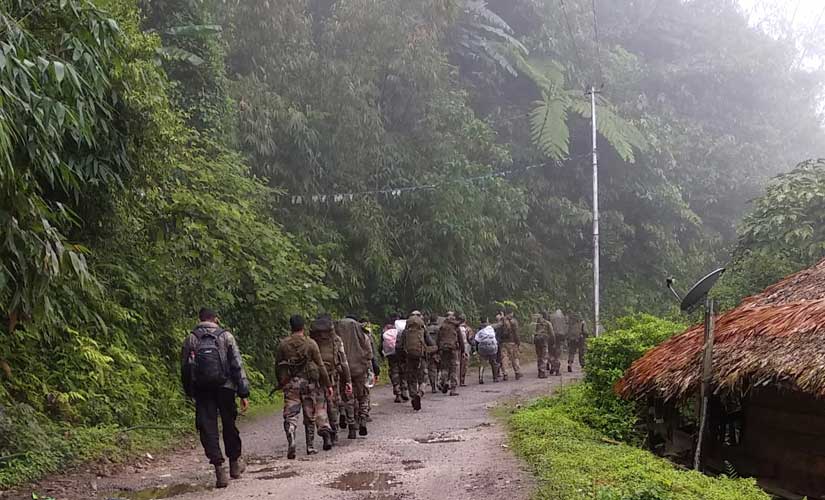 The 20-member foot team sent on Monday (17 June) returning back to the base. Photo credit Rishu Kalantri[/caption] Earlier in the day, Wing Commander Ratnakar Singh had said that no airborne operation could be undertaken on Wednesday because of bad weather. However, the IAF managed to drop rations for those camping near the wreckage site through a small opening in the dense cloud cover, another source said. Day 15, 17 June: Reinforcement inducted The Indian Air Force sent a 20-member foot team as reinforcement to retrieve the bodies of the 13 IAF personnel. The decision came after inclement weather, low clouds and rainfall blocked all air-borne operations for three days in a row. According to sources, the civil administration were of the opinion that services of porters should be used to retrieve bodies. “The foot team comprised four IAF Garud commandos, four Spear Corps (Special Forces) personnel of the army, one civilian hunter and 11 porters,” said Wing Commander Singh. The 20-member team which started trekking to the crash site from Hirong — the last road head, under Tato circle, on the west of the crash site, in Shi-Yomi district on Monday (17 June), was in addition to the 15-member team which was air-dropped on 12 June, a day after the wreckage was spotted to look for survivors. Three civilians were air dropped a day later to assist them. The second team was tasked to carry rations for the mountaineers camping at the wreckage site and to bring back the bodies. Deputy commissioner of Siang district Rajeev Takuk said, “Though the crash site falls in Siang district, the foot team was inducted from Shi-Yomi district because the trek to the crash side is shorter than the one from Siang district. It would take minimum two-days for the foot team to reach the crash site by trekking from the western side of the crash site which falls in Shi-Yomi district.” [caption id=“attachment_6860161” align=“alignnone” width=“825”] 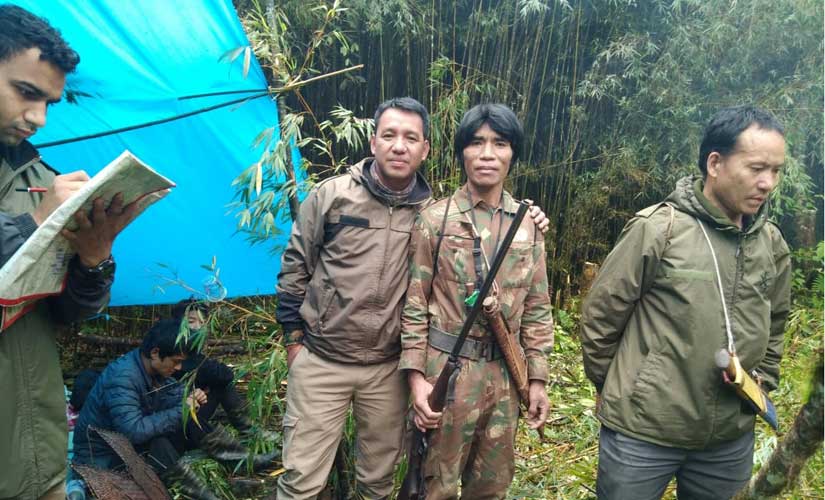 Picture of a part of foot team waiting outside a temporary camp established deep inside jungles in Pidi circle of Shi-Yomi district. The person (second from right) is the civilian hunter, known as Tarzan. Rishu Kalantri[/caption] “The weather in the hills changes suddenly and remains packed off for days. The IAF should have had a plan B to take out the bodies so that it could be handed over to the families at the earliest,” a source said, who wished not to be named, and added one can’t wait for the weather to open up. It may take days, here in this part of Arunachal Pradesh.
The source said, the IAF should have got in touch with the local administration and engaged willing local porters from day one itself to help lift the bodies. Things could have been done on a war footing instead of waiting for sunny days to meet the emergency.
“The services of porters were instrumental for transporting electronic voting machines and other important things to conduct polls in remote locations in the recently concluded elections. In some cases, the election team and porters trekked across hills for almost two days to reach the destination,” Day 12 to 17, 14-17 June: Bad weather blocks air-borne operations The operation to retrieve the mortal remains of the air warriors had been put on hold for three consecutive days in a row from Friday to Monday, as inclement weather and rainfall did not allow the helicopters to take off and winch out the bodies. [caption id=“attachment_6860181” align=“alignnone” width=“825”] 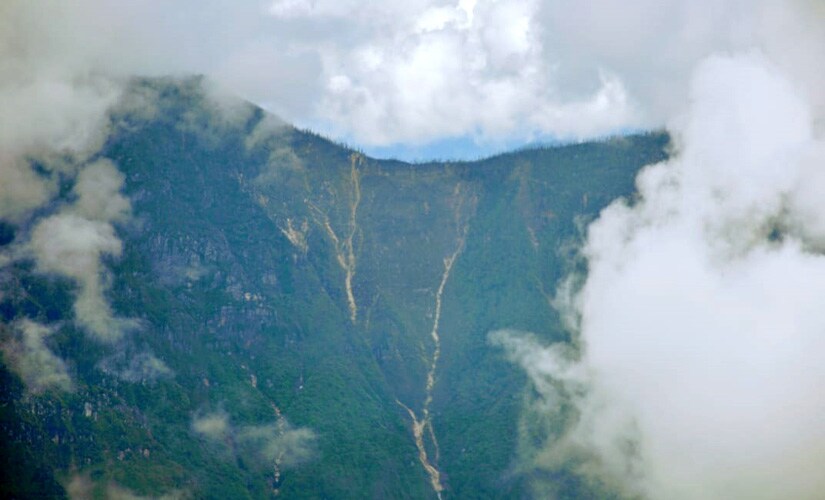 The valley with low clouds blocking air-borne operations. Photo credit Rishu Kalantri[/caption] The development came three days after the wreckage was spotted on 11 June at an altitude of 12,000 metres in the dense mountainous terrain, and at a time when family members are waiting for the bodies of their loved ones in Jorhat and in their native places. Air force Wing Commander Ratnakar Singh said, “Helicopters are on standby but unable to take off because of rain and very low clouds.” IAF declares all 13 persons on board dead as the mountaineering team reaches the crash site; Day 11 to 13 June All the 13 persons on board the AN-32 transport aircraft of the IAF that crashed on 3 June died, the IAF said on Thursday (13 June), two days after the plane’s wreckage was sighted in Arunachal Pradesh’s Siang district.
#Update on #An32 crash: Eight members of the rescue team have reached the crash site today morning. IAF is sad to inform that there are no survivors from the crash of An32.
— Indian Air Force (@IAF_MCC) June 13, 2019
IAF Pays tribute to the brave Air-warriors who lost their life during the #An32 crash on 03 Jun 2019 and stands by with the families of the victims. May their soul rest in peace.
— Indian Air Force (@IAF_MCC) June 13, 2019
Impact Shorts
More ShortsA highly placed source said only seven bodies have been spotted so far. “The bodies, partly burnt, were found buried underneath stones and sliding, except one. The recovery team could not take out the bodies on Thursday and will attempt to retrieve the bodies on Friday,” he added. “An IAF helicopter tried to lower winch but could not reach the site as the gradient was too high, hence, dropped nine rescue bags, in possession with the recovery team camping near the crash site. Recovery by helicopter through winching will be attempted on Friday (14 June),” the source said, adding that the aircraft’s black box has been recovered. Other recoveries include an iPad, a flight manual, a map and some personal belongings, including ID cards, wallet and luggage, motorcycle key and so-on. [caption id=“attachment_6860291” align=“alignnone” width=“825”]  IAF helicopter during an airborne operation at the crash site. Photo credit Rishu Kalantri[/caption] “The retrieval of the black box will be key to establish the sequence of events which led to the crash and do course correction in the future. The flight data recorder and the cockpit voice recorder are part of the black box that will help in investigations,” an IAF official said. The families of the deceased have been informed. The 15-member team — nine IAF personnel including four Garud commandos, four commandos from Spear Corps (special forces) of the army and two civil mounatineers Taka Tamut and Kishon Tekseng, who had scaled Mount Everest in 2018 — were air-dropped near the crash site on Wednesday (12 June) to look for survivors and recover the aircraft’s black box. “They navigated through the jungle but could not reach the wreckage and established a camp 100 metres from the crash site to start recovery operation on Thursday (13 June) morning,” a highly placed source privy to the rescue operations said. [caption id=“attachment_6860341” align=“alignnone” width=“825”] 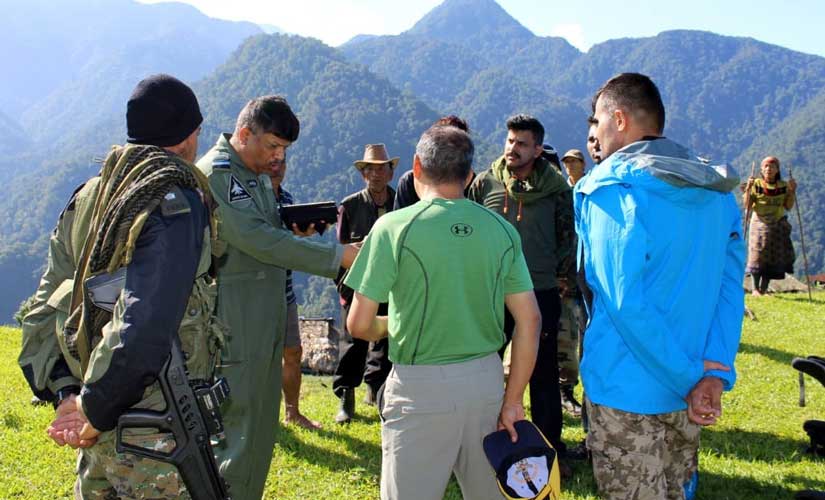 Senior Air Staff Officer of the Eastern Air Command of IAF Air Marshal Sandeep Singh briefing the team of 15 mountaineers and commandos before their indiction to the mission. Photo credit Rishu Kalantri[/caption] The IAF tweeted at 1.51 pm:
#Update: #Rescue Operation for the crashed An-32 is in full swing by #IAF. Additional resources have been mobilised to search for survivors. 04 Garuds of #IAF as part of the recovery party were dropped by helicopter near the crash site, where a camp has been established.
— Indian Air Force (@IAF_MCC) June 12, 2019
On 12 June, Siang superintendent of police Kushal Pal Singh said, “We are awaiting communication from the recovery team. Hence, nothing can be said about survivors now.” Day 9, 11 June: Wreckage spotted The wreckage of the Indian Air Force aircraft that went missing on 3 June with 13 people on board was spotted 16 kilometres north of Lipo in Arunachal Pradesh on Tuesday, an IAF statement said. [caption id=“attachment_6860371” align=“alignnone” width=“825”] 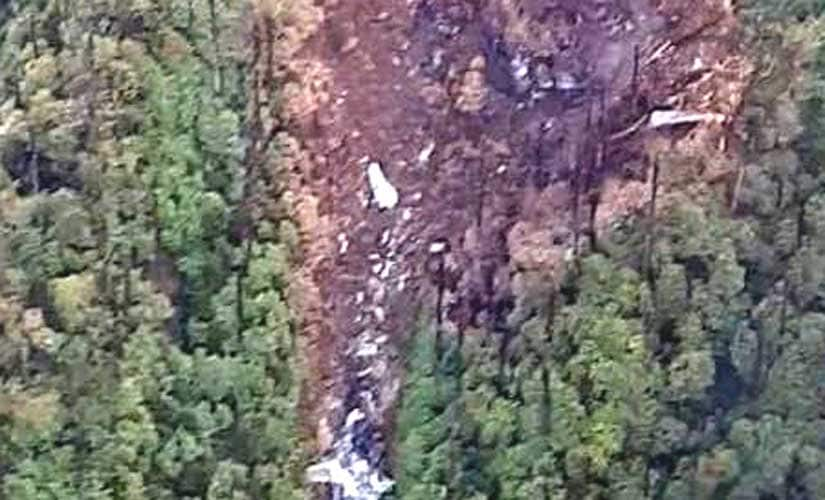 Picture of the wreckage of the IAF AN-32 on the slopes of Pari Adi (Padi hills) in Arunachal Pradesh’s Siang district. Photo credit Rishu Kalantri[/caption] The IAF posted on Twitter at 3.21 pm:
The wreckage of the missing #An32 was spotted today 16 Kms North of Lipo, North East of Tato at an approximate elevation of 12000 ft by the #IAF Mi-17 Helicopter undertaking search in the expanded search zone..
— Indian Air Force (@IAF_MCC) June 11, 2019
Another tweet, posted two minutes later read:
Efforts are now continuing to establish the status of occupants & establish survivors. Further details will be communicated as the recovery actions progress.
— Indian Air Force (@IAF_MCC) June 11, 2019
“The latitude and longitude of the wreckage site is 28 degrees 39’59"N and 94 degrees 29’16"E,” a highly placed source said, and added the deputy director of Arunachal Pradesh Energy Development Agency, Somar Potom, deputed by the West Siang district administration on the search mission, boarded the IAF helicopter that spotted the wreckage at Aalo and communicated the administration. “After identification of the wreckage of AN-32 by Mi-17V5, the Cheetah of IAF and ALH of the Indian Army reached the crash site. Due to high elevation and dense forest, helicopters could not land next to the crash site,” the air force tweeted at 7.46 pm. Immediately afterwards, another tweet read: “However, nearest landing site has been identified and the rescue operation by helicopters will commence tomorrow early morning. Ground forces will continue to reach the crash site during the night.” Wing commander Singh said: “Mountaineering teams of IAF, Indian Army and civilians are being formed now. They will be inducted on 12 June by means of helicopters, to look for survivors and other things. No exercise is taking place now to reach the crash site by road.” The sources said all 13 persons on board are feared killed but there is no official word yet. A communiqué by West Siang district information and public relations officer Gijum Tali said, “The aircraft seems to have lost control at Payum after take-off from Jorhat and appears to have turned left towards Mechuka from Gasheng village before finally losing full control near Gatte village. The area has tough topography and terrain and retrieving the bodies may take some time. The army and local Arunachal scouts are moving towards the spot.” “The helicopter was found in the same direction which few villagers had pointed. Molo village is the last road head to reach the spot, from where Gatte village is almost a 10-hour trek, and crash site more than a day trek. The mountaineers will be part of army and IAF team which will move tomorrow morning on choppers,” Siang superintendent of police Kushal said. Shi-Yomi deputy commissioner Mito Dirchi said, “One of my officers informed me around 2 pm that the aircraft has been spotted near Gatte village in Siang district.” The search and rescue mission gained momentum on Tuesday after clear skies opened the way for aerial sorties after three days of inclement weather and low clouds. Day 1-8, June 3 to 10: Initial leads come from villagers, CDR of mobile of passenger The search and rescue (SAR) mission carried out by the Indian Air Force to locate the missing AN-32 transport aircraft entered the eighth day, becoming the longest such mission undertaken in the history of Arunachal Pradesh. The state has witnessed a number of air crashes over a decade. The Indian Navy and ISRO joined the search and rescue operation for the Indian Air Force’s AN-32 transport aircraft on Tuesday (4 June), a day after the aircraft went missing on Monday (3 June) with 13 persons on board. The navy’s P8i, a long-range maritime reconnaissance aircraft, took off from INS Rajali, Arakonam, Tamil Nadu at 1 pm. The navy tweeted on 4 June at 2.04 pm: “The aircraft shall carry out search with Electro Optical and Infra Red (EO & IR) sensors in thickly forested areas”. Another tweet at 2.21 pm read: “The P8i aircraft has a very powerful Synthetic Aperture Radar which shall be utilised during the SAR sweeps to locate the missing @IAF_MCC #AN32”. An IAF source said Cartosat and Risat satellites of the Indian Space Research Organisation (ISRO) have also been pressed into service. On 4 June, Wing Commander Singh told this correspondent that the IAF’s C-130J aircraft carried out three search-and-rescue sorties on Monday night but was unable to sight the aircraft. “The operation resumed on Tuesday as the weather cleared. A SU-30 carried out search and recce mission in the afternoon. Two SU-30, two Mi17 and one advance light helicopters are already deployed with the ground teams of the army and the Indo-Tibetan Border Police. More assets may be deployed. The IAF is making every effort to locate the aircraft,” he said.
“P8i finished the search and recce mission at 6.45 pm and will be used again if required. Post sunset, search by helicopters have ceased for the day. However, search by all sensors with night capability and the ground party will continue throughout the night,” he added. The nine-day long search, that saw deployment and use of assets from various agencies including ISRO, Indian Navy and the army besides most of the aircraft and helicopters of IAF carried out regular sorties in search of the plane, had spread to 2,500 kilometres. The inclement weather hampered the search very often. Arunachal chief minister Pema Khandu tweeted at 10.40 am on Thursday (6 June):
State police force along with Army & Air force has been mobilized to locate the missing @IAF_MCC AN-32 Aircraft that was bound for Mechuka on Monday. The search operation covering four district spread around 2500 sqkm is being intensified. Praying for success of search operation.
— Pema Khandu པདྨ་མཁའ་འགྲོ་། (@PemaKhanduBJP) June 6, 2019
Three minutes later, he again tweeted:
Have asked DCs of four districts- Siang, West Siang, Lower Siang & Shi-Yomi to intensify search operation and also appealed the villagers of adjoining areas falling in the probable route of the aircraft to provide any sort of information on missing aircraft AN-32.
— Pema Khandu པདྨ་མཁའ་འགྲོ་། (@PemaKhanduBJP) June 6, 2019
The initial lead came on Thursday (6 June) when Tumbin villagers in Arunachal Pradesh reported seeing thick black smoke billowing from a mountain towards Molo village in Siang district on Monday afternoon. “This is being verified,” Director-General of police SBK Singh informed the Chief Minister’s Office. “The authorities of Siang and West Siang districts have formed three teams to search as many mountain ranges on the aircraft’s route,” a CMO statement said. The call detail record of one of the passengers on the missing AN-32 showed the last mobile location at Kaying in Arunachal Pradesh’s West Siang district at 12.55 pm, five minutes before the transport aircraft disappeared from the radar on 3 June, giving direction to the search, investigators told this correspondent. West Siang district deputy commissioner Swetika Sachan said, “We are coordinating with the IAF and other agencies involved in the search operations. All inputs are being worked upon.” Wing Commander Singh said on Thursday (6 June), “Initially the aerial search was held up due to bad weather and low clouds. However, there was a marginal improvement in the weather and IAF intensified the search for the missing aircraft. Based on various available inputs, the search area was expanded. Ground forces also joined the search. Mission by UAV and C-130 are planned for the night in coordination with the ground teams. IAF is committed to finding the missing air warriors.” “We are trying to make all-out efforts though bad weather is constantly hampering the progress of the mission to a great extent. So far there are no clues from any teams who are out at various locations,” said Siang superintendent of police Kushal. “We are trying to cover as many ranges as possible. Some ranges are very vast like the Shikhar Kamchi range and two teams have been launched from different directions to cover as much ground as possible in the shortest possible time,” Singh said. He also informed that eight teams were on the search and rescue mission on Sunday ( 9 June) . According to him, a few parties would leave early in the morning and return by night, while others would stay in the jungles, to advance the next day to reach the target areas. These teams would send wireless communication immediately on finding any clue or evidence. “Kaying police station has been temporarily converted into a control room for the search and rescue mission, with a temporary W/T (wireless) station set up at Molo village as there was no mobile network in the region,” he added. Reward announced On Saturday (8 June), IAF announced a reward of Rs 5 lakh to anyone providing credible information on the missing An-32 aircraft. The Siang district administration and police had also announced Rs 50,000 and Rs 20,000 respectively for providing information, a day before. From the pen of deputy commissioner of Siang district, Rajeev Takuk ad verbatim: “On 3rd June 2019, I got a call from DC Jorhat (Assam) at about 3.00 pm on the missing of IAF AN-32 aircraft on a flight from Jorhat to Mechuka (Shi Yomi district). The DC and SP swung into action immediately. Basing on the report that the plane last contacted the ground control at 12.56 pm while approaching Molo (Bille) in Siang district a police team was despatched to Kaying, Tumbin, Roying and Molo area. Accompanying by local villagers the suspected areas were visited but nothing could be found. From 04.06.19 onwards the district administration mobilised villagers of two circles viz Kaying and Payum to comb within the respective village jurisdictions. Two teams of local hunters were also formed to locate the missing plane in Bayor Hills (the traditional route) of aircraft flying to Mechuka. The DC Shi Yomi also sent police personnel and local people to locate the plane in Tato, Yapik and other areas of the district. On 6.6.19 the DC Siang ordered all GBs of the locality to send special village experts to scan the entire hills, ravines and gorges. Scouts were engaged in large numbers @ Rs 800/- per day per person. Search and rescue teams were provided food items, torches, mobiles, boots, raincoats and sundry items. The district administration also announced a reward of RS 50,000/- to any person or group which may locate the missing aircraft or any information that may lead to finding it. The district police also announced Rs 20,000/- on the same lines. Despite inhospitable terrain and inclement weather the S&R teams continued the operation day in and day out. All other required teams like power, medical, Tpt, water supply, food and shelter were kept ready during the entire operation. The DCs and SPs of neighbouring districts like West Siang, Upper Siang and Upper Subansiri were intimated. Above all the voluntary services of ABK (Adi Bane Kebang) and local mountaineers were ropped in. The local mountaineers who joined the mission are Taka Tamut (Everester), Kison Tekseng (Everserter), Talik Darung, Okewmang Mize, Tagum Tamut. Since the western, southern and eastern parts were already rummaged the mountaineers were sent to the upper region of Payum three days foot march from the nearest road head. The team reached Gasheng village yesterday (10.6.19). Today, two of the local mountaineers boarded the MI-17 helicopter along with others and finally helped inl ocating the wreckage of the ill-fated aircraft in Pari Adi (Pari Hills) about 12/13 kms from Gate village - the last and northernmost village of Siang district. The five local mountaineers will again be engaged tomorrow (12.6.19) in the recovery of wreckage. Payum circle is bereft of any road connectivity. The entire area is filled with treacherous hills, ravines, rivers and gorges. Despite all hurdles in the inhospitable terrain the local administration / the local people did commendable work in the eight-day-old ordeal. In the process, no stone was left unturned to see that the missing plane was located. The district administration and its people worked relentlessly from 3.6.19 to 11.6.19. The operation has been called off this afternoon. The cost of entire operation is estimated to be around Rs 4 lakh. Signed, Rajeev Takuk on 11.6.19.” Not a challenge, but a mission The search of missing Indian Air Force transport aircraft An-32 may have come to an end after its wreckage was on Tuesday (11 June), but the day by day account of the nine-day frantic search came to light on Wednesday after a five-page letter pen down by the deputy commissioner of Siang, Rajeev Takuk, surfaced on Wednesday (12 June) for the first time, underlining the hardships and role district administration and its people played in the entire mission. The developments before the ill-fated aircraft went missing on 3 June The aircraft’s estimated time of arrival (ETA) at the advanced landing ground (ALG) in Mechuka was 1.12 pm. “It made last contact with ground forces at the air traffic control (ATC) tower in Jorhat at 1 pm to report its mandatory communication before disappearing. The pilot, Ashish Tanwar, 29, reported at all the mandatory positions to the ground team before reaching Mechuka. He was reporting to the IAF tower in Jorhat where his wife Sandhya was on duty — among the first ones to learn about the missing aircraft,” a source in the IAF told this correspondent. History of air crashes in Arunachal Pradesh in the last decade In June 2009, one AN-32 crashed soon after takeoff from Mechuka, killing all 13 persons, seven of the air force and the rest from the army on board. The wreckage of the aircraft was found at Tato, near Mechuka ALG, almost 24 hours later. On 30 April, 2011, five persons, including Arunachal Pradesh chief minister Dorjee Khandu and two pilots, who took off in a single engine EuroCopter B8 of Pawan Hans, died after the chopper crashed between Kyela and Lubuthang near Tawang district. The wreckage was found on 4 May, 2011. In October 2017, five IAF crew members and two army officers were killed after an IAF Mi-17 V5 helicopter, on an air maintenance mission, crashed near Tawang in Arunachal Pradesh. The wreckage was sighted within 24 hours. Three months earlier, on 4 July, an IAF advanced light helicopter had crashed at Sagalee, in Papum Pare district, killing all four on board. The helicopter had been deployed to rescue passengers stranded between Sagalee and Itanagar and was recovered within 24 hours. Flying in the valley Flying in the valley is a different ball game altogether and it brings unique challenges as aircraft are off the radar most of the time. “In the hills, the line of sight gets broken due to high mountains, and often the aircraft is not under radar coverage for 24 hours. In these cases, the pilot is not instructed by officials sitting at the air traffic control towers to facilitate maintain a smooth path, as it happens in the normal course. Here reporting action needs to be initiated by the pilots. “Flying in the valleys are always under Visual Flight Rules (VLR) regulations, which implies ‘see and be seen’, and is a must for pilots to go for such missions,” a former pilot and having the expertise of this region said. [caption id=“attachment_6860751” align=“alignnone” width=“825”] 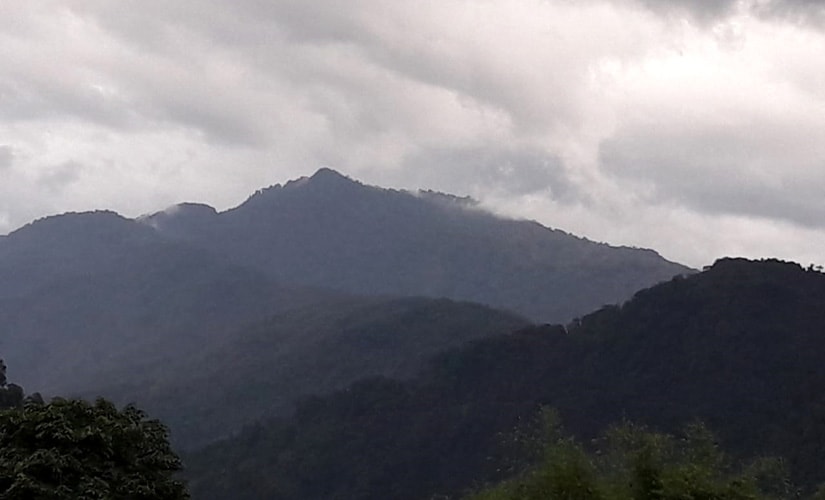 Picture of a valley in Arunachal Pradesh. Photo credit Rishu Kalantri[/caption] He added, “There are no radar vectors or Jeppesen approach plate that safely guides pilot down to a thousand-feet runway. Transport aircraft like AN-32 have very little elbow room to negotiate such routes. Their turning radius vis-a-vis the lay of the hills and valleys can trap them with little choice, hence bad weather makes it a deadly combination.” Flying to the advance landing grounds are always under Visual Met Conditions (VMC), which implies that the pilots are visible from the ground and clear of terrain and clouds. In case the VMC condition ceases to exist, the operations to these ALGs are not carried out, a source in IAF said. “Flying in Arunachal Pradesh is always risky, which has hostile terrain coupled with unpredictable weather where any technical snag could be disastrous. Hence, a latest aircraft or an upgraded one can play a crucial role there,” former Vice Chief of Air Staff, Air Marshal (retired) Pranab Kumar Barbora said, and added the weather may be clear at the time of take off, but it packs up all of a sudden, hiding mountains behind the clouds, blocking the smooth exit. “The air force has conducted a lot of research which has led to the successful night landing of the AN-32 at Mechuka. There is no radio communication to suggest there was any technical snag on the missing aircraft. I also do not doubt the capabilities of our pilot,” Barbora said and added that all IAF aircraft are cleared to fly by competent people on the base. “This trap is common. ask any pilot who flew in the valley of Arunachal Pradesh. Most of them have similar stories to tell, a former pilot echoed.


)

)
)
)
)
)
)
)
)



